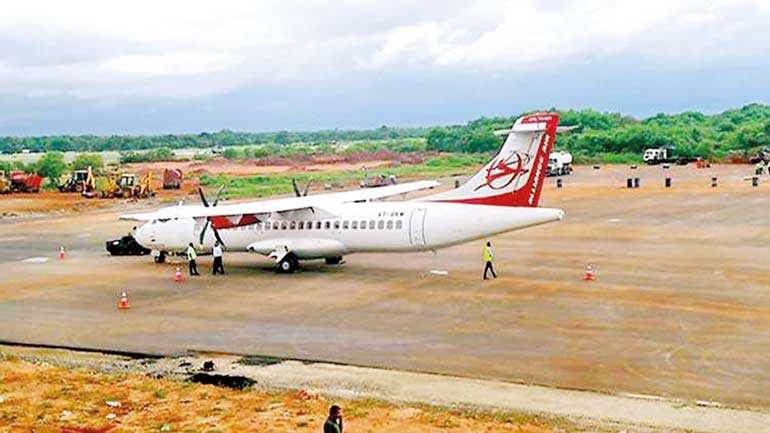Saturday Dec 14, 2024
Saturday Dec 14, 2024
Monday, 6 January 2020 00:00 - - {{hitsCtrl.values.hits}}

The big story in Sri Lanka was of course the opening of Jaffna’s international airport, and the inauguration of operations by Alliance Air
Aviation’s main story of the last year has been, of course, the 737 MAX accidents and all the controversy surrounding this aircraft. The significance and commercial impact of this ongoing saga, has masked what was otherwise another successful year for the industry.
Safety
Notwithstanding the media frenzy surrounding the second MAX accident (Ethiopia March 2019) the year has been a very safe one. A total of 20 accidents were recorded, 13 of which were passenger flights. With over 39 million flights conducted throughout the year, the accident rate is about one in every two million. This represents a more than 50% improvement in the last 10 years, a significant achievement.
Industry
Boeing in trouble
Boeing has been the headline story of the year, the MAX debacle resulting in losses of almost $ 5 billion to-date. With the stoppage of production in December, this is only going to get worse. Over 300 MAXs had been delivered when the aircraft was grounded and another 400+ have been built since. This has savaged Boeing’s bottom line and the darling of Wall Street has lost its CEO as it struggles to cope with the situation. 
Airbus consolidates
Airbus has had a much less dramatic year. Sales of its narrow body A320 family broke records, indicative of the fact that it has no rival at present with the MAX being grounded. The launch of the A321XLR (extra long range) version of its best-selling aircraft has been a winner. The successful integration of the Bombardier C-Series, now dubbed the A220, into the European plane maker’s family of aircraft and the sales success of this type, has cemented Airbus’s position at the top of the tree.
Larger aircraft sales plummet
Of some concern to both manufacturers have been the sluggish sales of the larger wide-body aircraft. Airlines seem to be tiring of these expensive beasts; Boeing latest 777X having being delayed again and not selling well.
Airbus was compelled to announce the upcoming end of production of its flagship A380. Many airlines are returning the older models of the giant aircraft to the owners and the first examples are being dismantled as we speak. That has been a huge blow to the European manufacturer’s flagship product. Sales of the A350, rival to Boeing’s 777, have also been slow moving.
Industry trends
Canada’s Bombardier has all but exited the aircraft scene, with the C-Series sold to Airbus and the CRJ regional jet program also divested: Mitsubishi of Japan acquiring it. The SpaceJet M90, Mitsubishi’s own entrant to the airliner market, is approaching certification and deliveries are expected to commence in 2020. Meanwhile China’s COMAC, with its A320 rival the C919, has been moving forward. Six prototypes are currently flying and the manufacturer expects certification to be completed in 2020, with the first deliveries occurring in 2021.
Russia’s rival MC-21, also aimed at the same market segment, is nearing certification too, with the fourth prototype flying on 25 December. However the crash of a Sukhoi Superjet in Moscow in June 2019 has overshadowed these developments.
With the cause of MAX accidents being attributed to a failed certification process (as readers of this column are aware) it is likely that all new types will be under increased scrutiny. Achieving certification will be a challenging task for all these manufacturers; despite their years of experience in designing and producing complex aircraft.
Airlines
The airline world continued to be largely profitable in 2019, though slowly increasing fuel prices have dampened performance somewhat.
Overcapacity has been the millstone hampering airline profits in the recent past. In a perverse way, the MAX debacle has helped as it led to a reduction in capacity, which has helped stabilise the narrow body segment of the industry. The 700 or so grounded MAX aircraft have around 130,000 seats, which represent many million Available Seat Kilometres (ASKs) that have been taken off the market.
The Indian airline scene
The major story in the region was the collapse of Jet Airways in April 2019. India’s fast growing market continues to consolidate, with Indigo and Spicejet being the main beneficiaries of Jet’s demise. Spicejet in particular was able to acquire many of Jet’s 737s, thereby offsetting the grounding of 13 MAX aircraft.
Indigo made a record order for 300 Airbus A320 family aircraft, putting itself on track to have over 700 aircraft in the foreseeable future. This makes India’s largest Low Cost Carrier one of the world’s biggest, with only America’s Southwest having more aircraft in the LCC segment.
Air Asia India and Go Air, both LCCs, continue to grow. Vistara, a full-service based in Mumbai, has commenced flights to Colombo.
Air India the largest legacy airline in the region continued to lose money, with the Modi government trying once again to find a buyer for the beleaguered national carrier. An attempt to find a purchaser earlier in 2019 failed, with not a single offer being received. Another privatisation initiative is scheduled for early 2020. Hardeep Singh Puri, the head of India’s civil aviation ministry, has gone on record to state, “…the airline will have to close down if it is not privatised”. Whether this is an empty threat or a more pragmatic approach to a business that is on track to lose a billion dollars in 2019, remains to be seen.
Europe
Alitalia, the European equivalent of Air India, also continues to struggle. Owing the Italian government over one billion Euro, the carrier is estimated to have cost the government a total of € 9 billion in taxpayer funded handouts.
Thomas Cook, one of the world’s oldest travel companies was forced into bankruptcy in 2019. Germania, a smaller privately held European airline, also ceased operations. Norwegian, a long-haul LCC, has just managed to stay afloat by selling off assets and cutting costs dramatically. The MAX debacle has hurt Ryanair, Europe’s largest airline, quite badly. The airline is reducing costs, closing bases and making crew redundant, in anticipation of further delays to the aircraft. Ryanair operates only Boeing 737s and so is very exposed to problems with the type.
Asia
Cathay Pacific, once the strongest of Asia’s legacy carriers has had an awful year. Street protests in Hong Kong, the carrier’s base, caused travel numbers to plummet. Hong Kong Airlines, also based there, narrowly escaped closure and has lost a significant portion of its fleet to creditors, as the protests take a huge toll on the region’s performance.
Malaysian Airlines is also struggling with another attempt at restructuring having failed to produce a financial turnaround. The $ 1.5 billion poured in by the previous government to the national carrier has had little effect. The airline lost $ 750 million last year and the newly re-elected PM Dr. Mahathir has publicly spoken about being forced to close it down.
The Gulf mega-hubs
For the first time in decades, one Gulf based airline has been shrinking instead of growing. Abu Dhabi’s Etihad has been forced to rationalise its fleet and operations just as a lavish new terminal was opened at its home airport. A tacit acceptance that there was just no room for three huge airlines in the area, is the first hint that consolidation may be coming to the Gulf too.
Emirates have signalled the coming end of an era, with its pioneering President Sir Tim Clark due to retire in 2020. The A380, Sir Tim’s aircraft of choice, is still the flagship and the airline operates over half 380s flying today. But future orders of A350s and B787s and the coming retirement of some of the older A380s are indications that this type can no longer compete.
Qatar Airways continues to expand, despite a crippling blockade by some of its Gulf neighbours and significant losses. The airline has also increased its shareholding in many other companies, now owning stakes in British Airways, Cathay Pacific, Air Italy, American Airlines, China Southern Airlines and LATAM and South America.
Jaffna International Airport
The big story in Sri Lanka was of course the opening of Jaffna’s international airport, and the inauguration of operations by Alliance Air. Scheduled flights between Jaffna and Chennai have commenced several times a week and loads appear to be healthy.
Jaffna has the potential be a vibrant commercial airport, but will need considerable investment to be truly viable. Whether this will be a priority for the newly elected government of Sri Lanka, only time will tell.
SriLankan Airlines has a new Chairman, the fourth since April 2018. What the new government will do with the national carrier should be interesting to watch.